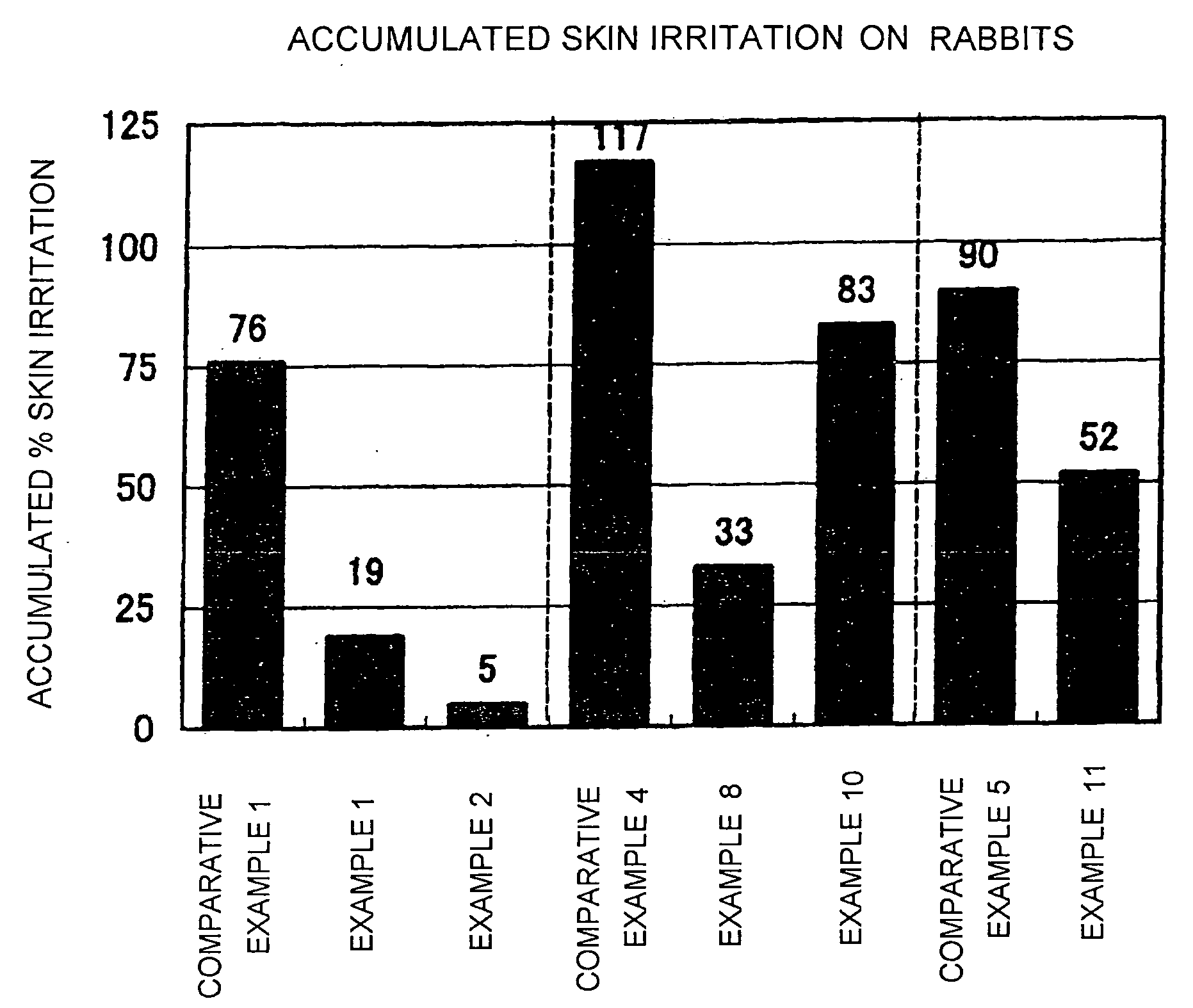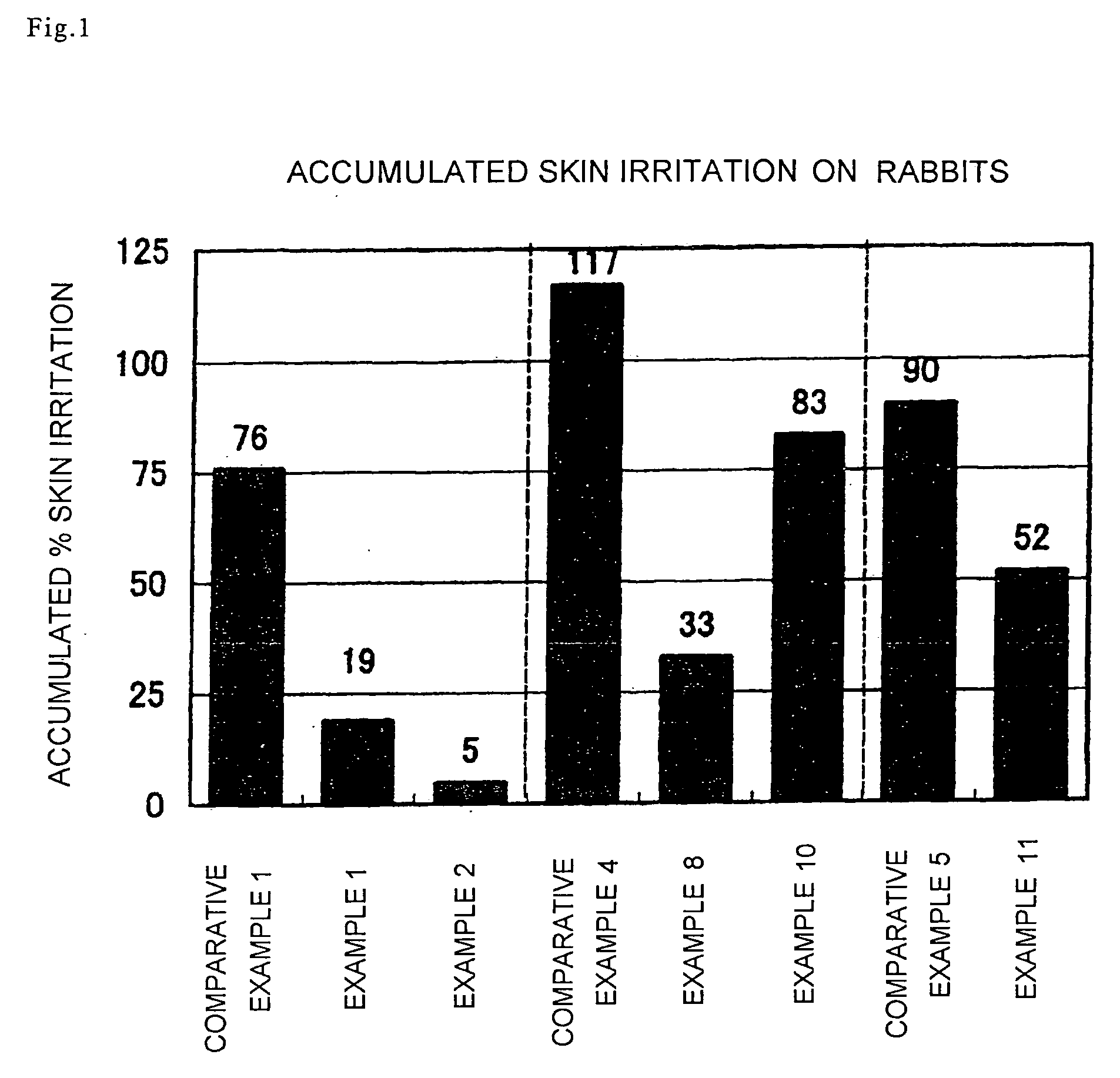Lowly irritative adhesive patch
a patch and adhesive technology, applied in the field of adhesive patches, can solve the problems of skin stress generation, rubor and rash, occurrence of tissue destruction of the skin surface, etc., and achieve the effect of reducing skin irritation and reducing the generation of rash
- Summary
- Abstract
- Description
- Claims
- Application Information
AI Technical Summary
Benefits of technology
Problems solved by technology
Method used
Image
Examples
example 1
[0053]Into a base component made of 22 wt % of polyisoprene IR-2200 (manufactured by ZEON CORPORATION), 12 wt % of polyisobutylene L-100 (manufactured by Exxon Mobil Corporation), 8 wt % of styrene-isoprene-styrene block copolymer Quintac 3710 (manufactured by Shell Chemicals Japan Ltd.), 16 wt % of Alcon-P100 (manufactured by Arakawa Chemical Industries, Ltd.), and 16 wt % of liquid paraffin, 6 wt % of zinc oxide, 4 wt % of hydrous silica, and 1.0 wt % of sucrose fatty acid ester [Ryoutou Sugar Ester S-370F (manufactured by Mitsubishi Chemical Foods)] were added and mixed. Subsequently, 6 wt % of methyl salicylate, 6 wt % of 1-menthol, 1 wt % of dl-camphor, and 2.0 wt % of tocopherol acetate were blended, and the mixture was extended on a staple fiber muslin base cloth so as to have a thickness of 200 μm, and the resultant was covered with a release paper that had been subjected to a silicone process. The resultant was cut into a desired shape to form an adhesive patch of the prese...
example 2
[0054]Into a base component made of 20 wt % of polyisoprene IR-2200 (manufactured by ZEON CORPORATION), 12 wt % of polyisobutylene L-100 (manufactured by Exxon Mobil Corporation), 8 wt % of styrene-isoprene-styrene block copolymer Quintac 3710 (manufactured by Shell Chemicals Japan Ltd.), 16 wt % of Alcon-P100 (manufactured by Arakawa Chemical Industries, Ltd.), and 16 wt % of liquid paraffin, 6 wt % of zinc oxide, 4 wt % of hydrous silica, and 3.0 wt % of sucrose fatty acid ester [Ryoutou Sugar Ester S-370F (manufactured by Mitsubishi Chemical Foods)] were added and mixed. Subsequently, 6 wt % of methyl salicylate, 6 wt % of 1-menthol, 1 wt % of dl-camphor, and 2.0 wt % of tocopherol acetate were blended, and the mixture was extended on a staple fiber muslin base cloth so as to have a thickness of 200 μm, and the resultant was covered with a release paper that had been subjected to a silicone process. The resultant was cut into a desired shape to form an adhesive patch of the prese...
example 3
[0055]Into a base component made of 7 wt % of polyisoprene IR-2200 (manufactured by ZEON CORPORATION), 13 wt % of polyisobutylene L-100 (manufactured by Exxon Mobil Corporation), 11 wt % of styrene-isoprene-styrene block copolymer Quintac 3710 (manufactured by Shell Chemicals Japan Ltd.), 19 wt % of Alcon-P100 (manufactured by Arakawa Chemical Industries, Ltd.), 5 wt % of polyisobutylene LM-MH (manufactured by Exxon Mobil Corporation), and 22 wt % of liquid paraffin, 4 wt % of zinc oxide, 3 wt % of hydrous silica, and 1.0 wt % of sucrose fatty acid ester [Surf Hope J1803F (manufactured by Mitsubishi Chemical Foods)] were added and mixed. Subsequently, 6 wt % of methyl salicylate, 6 wt % of 1-menthol, 1 wt % of dl-camphor, and 2.0 wt % of tocopherol acetate were blended, and the mixture was extended on a PET film so as to have a thickness of 200 μm, and the resultant was covered with a release paper that had been subjected to a silicone process. The resultant was cut into a desired s...
PUM
| Property | Measurement | Unit |
|---|---|---|
| wt % | aaaaa | aaaaa |
| thickness | aaaaa | aaaaa |
| physical stress | aaaaa | aaaaa |
Abstract
Description
Claims
Application Information
 Login to View More
Login to View More - R&D
- Intellectual Property
- Life Sciences
- Materials
- Tech Scout
- Unparalleled Data Quality
- Higher Quality Content
- 60% Fewer Hallucinations
Browse by: Latest US Patents, China's latest patents, Technical Efficacy Thesaurus, Application Domain, Technology Topic, Popular Technical Reports.
© 2025 PatSnap. All rights reserved.Legal|Privacy policy|Modern Slavery Act Transparency Statement|Sitemap|About US| Contact US: help@patsnap.com


